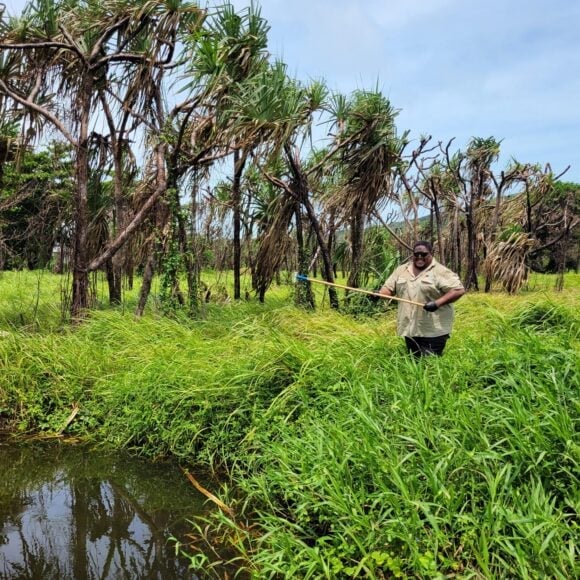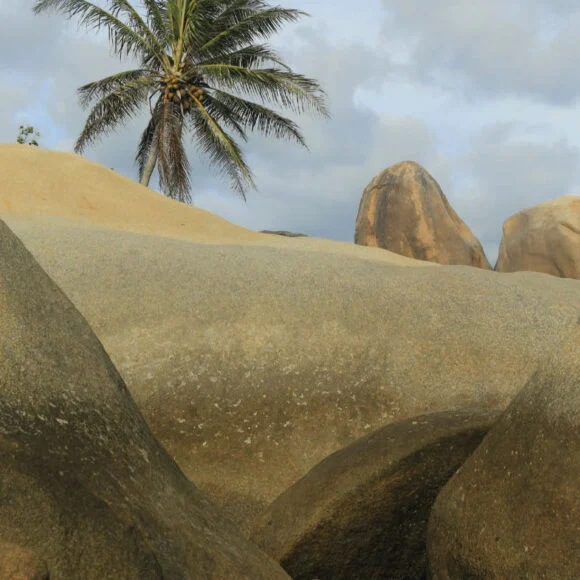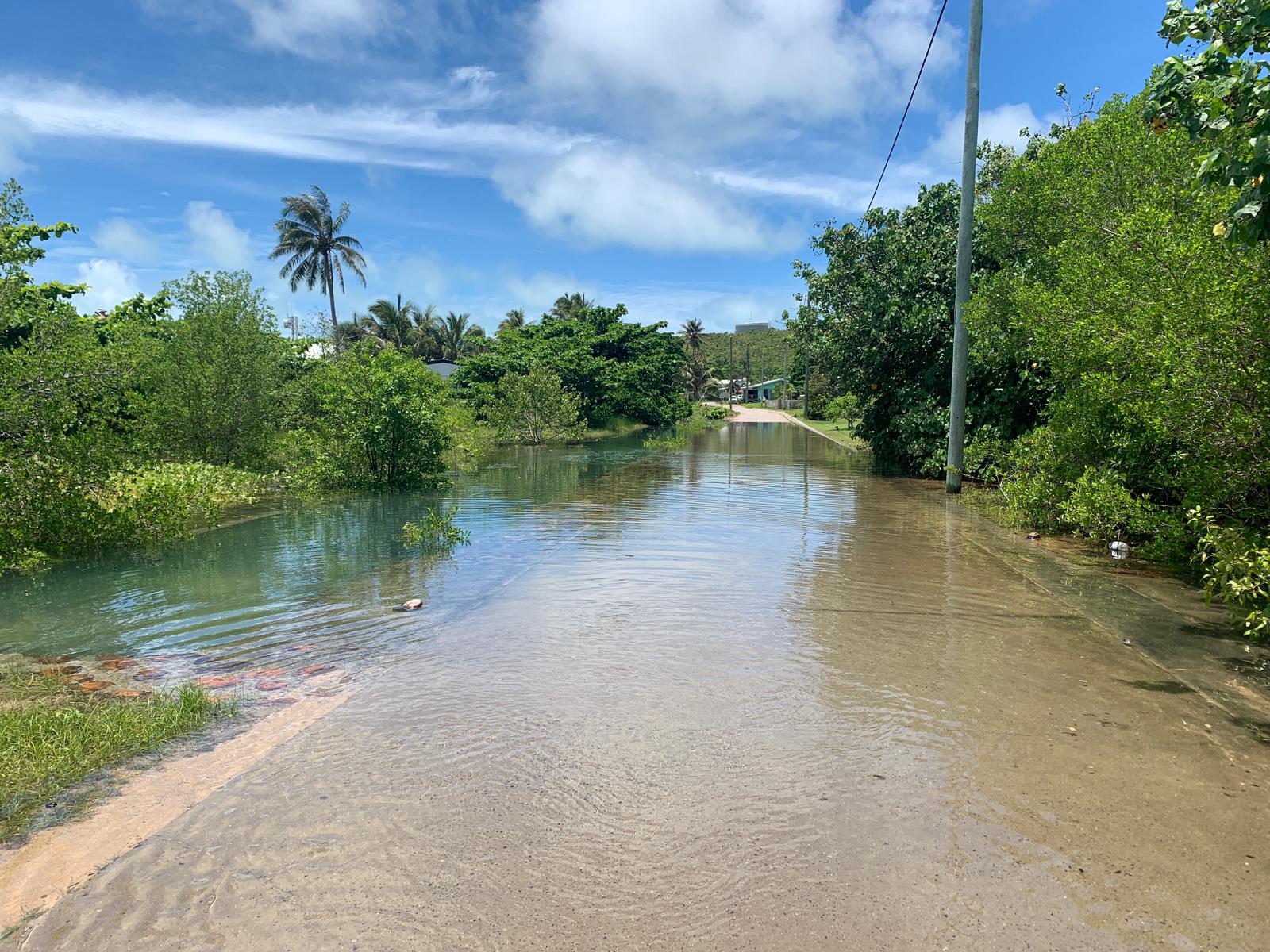Climate change in the Torres Strait
The Torres Strait sits at the frontline of multiple climate change impacts. From rising sea levels threatening low-lying island communities and impact on the region’s marine ecosystems and resources, to the health and social impacts of rising temperatures and extreme events.
The Torres Strait Regional Authority (TSRA) has been instrumental in leading the region’s response and will continue to play a key role in shaping and supporting ongoing planning and implementation of adaptation and resilience initiatives.
TSRA’s wholistic approach to climate change spans multiple sectors and includes focused activities on data collection and environmental monitoring through to strategic policy, planning and coordination.
The 2025-2030 Regional Adaptation and Resilience Plan – Yumi Create Our Future: Stronger Together highlights key focus areas to build regional and local climate resilience. This plan builds on previous regional climate change plans (Regional Adaptation and Resilience Plan 2016-2021, Torres Strait Climate Change Strategy 2014-2018 and the Torres Strait Climate Change Strategy 2010-2013).
TSRA works closely with the Department of Climate Change, Energy, the Environment and Water (DCCEEW), local government and community partners to build the region’s capacity to respond effectively to climate change through the Torres Strait and Northern Peninsula Areas Climate Resilience Centre.
Additional resources include:
- Draft Torres Strait Heat Risk Reduction Strategy 2024
- The Torres Strait Renewable Energy Transition Plan 2021
- Torres Strait State of Environment Report Card 2021
- Torres Strait Climate Change and Health – First Pass Risk Assessment 2018
- Torres Strait – Options to Reduce Regional Carbon Footprint 2012
- Observed and Future Climates of the Torres Strait Region 2011
- Torres Strait Extreme Water Level Study 2011
The Torres Strait Yumi Safe Disaster Dashboard provides up-to-date information on weather, tides and other useful situational awareness information for the region.
Our position on climate change
TSRA’s climate change initiatives sit within TSRA’s Strategic Policy Unit.
- The Torres Strait Regional Authority (TSRA) sees climate change as an existential threat to the communities, culture, and natural values of the Torres Strait.
- The TSRA will support communities and the environment in the region to adapt to climate change through its role as a regional facilitator and coordination agency, through its own Programs and through its role on the Torres Strait and Northern Peninsula Area Climate Resilience Centre (TSNPACRC).
- The TSRA will advocate for greater deployment of renewable energy and sustainable infrastructure solutions for the region.
- The TSRA will advocate for policy responses and funding required to enable the region to respond proactively and effectively to expected climate change impacts and to build climate resilience at local and regional scales.
Climate change poses an existential threat to the unique cultures, livelihoods, island communities and ecosystems and environments of the Torres Strait.
Sea level rise, increased land, sea and air temperatures, increased weather extremes and weather variability are already impacting the region, and these impacts are expected to increase significantly over the coming decades.
Torres Strait Islanders have made an inconsequential contribution to global greenhouse gas emissions yet will suffer disproportionally more from the impacts of climate change 1. Responding effectively to climate change goes beyond emissions reduction, it also requires there be social equity and social justice as integral principles informing our response.
Current understanding of long-term sea level rise indicates that most parts of the low-lying inhabited islands in the region will be lost to sea level rise. Torres Strait culture is inextricably linked to land and sea country. Consequently, the affected communities will lose not only their land and the land of the ancestors, but they will lose a critical and irreplaceable part of their culture and their identity.
The Torres Strait is a globally significant marine environment for dugong, seagrasses, marine turtles and coral reefs 2. All these now face unpredicted pressure due to the impacts of climate change on the marine environment. Australia and the world stand to lose these key environmental values and assets, and the people of the Torres Strait and neighbouring PNG stand to lose key parts of their culture, key subsistence resources and the important fisheries economy.
As Australia’s only inhabited international border region with Papua New Guinea, the Torres Strait is also highly exposed to potential consequences of the climate change impacts on neighbouring Papua New Guinea and Indonesia including increased pressure on local natural resources, the displacement of people and increased vector-borne and infectious disease health risks.
The longer the world takes to reduce greenhouse gas emissions, the greater will be the consequences, the greater the cost of responding and the fewer response options will be available. It is imperative all efforts are made to keep global average temperatures below the 1.5 oC aspirational target as agreed to by signatories to the UNFCCC Paris Agreement.
The TSRA is committed to supporting and advocating on behalf of Torres Strait communities to build resilience and to respond to climate change impacts on their culture, livelihoods, communities and natural environment.
TSRA currently in engaged in supporting the region in its climate change response through the following mechanisms:
- Development of the Torres Strait Regional Adaptation and Resilience Plan as the chief planning mechanism to coordinate and drive the region’s strategic response to climate change;
- Continuing to secure funding for priority adaptation measures in the Plan;
- Working with Traditional Owners and research organisations to build ecosystem resilience to climate change and support community capacity to deliver sustainable land and sea management;
- Strongly advocating for climate resilient and sustainable regional infrastructure, including advocacy for the transition to renewable energy;
- Supporting Torres Strait communities to strengthen their resilience to climate change including the development of capacities, local skills and employment opportunities associated with the development and implementation of local adaptation and resilience planning and actions;
- Working with other organisations in the region and with governments towards reform of governance and system change that will empower Torres Strait communities to adapt to climate change and help unlock potential in the region;
- Working with and assisting Councils and the Qld Government to implement a shift to a resilience approach that will enhance the readiness and responsiveness for emergencies and disaster events in the region.
1. Torres Strait Regional Adaptation and Resilience Plan 2016-2021
2. Torres Strait State of Environment Report Card 2021
Achievements
-
Established the Torres Strait regional coordination group to drive high level implementation of adaptation and resilience actions.
-
Monitoring local temperature and humidity to assess heat risks to communities.
-
Community shade tree project initiated through the Sustainable Horticulture Project.
-
Climate resilient communities pilot project with the communities of Masig and Mer.
-
School campuses supplied with weather stations and improved network of professional weather stations.
-
Emergency information dashboard established.
-
Shipping risk forums and field exercises completed with AMSA and MSQ.
-
Climate Change Heat Risk Assessment Report completed.
-
Climate Change impacts on marine ecosystems and Fisheries technical workshop.
-
Climate Change impacts on island ecosystems workshop.
-
Regional Sustainable Waste Management Workshop.

Resources
-
Project documents



